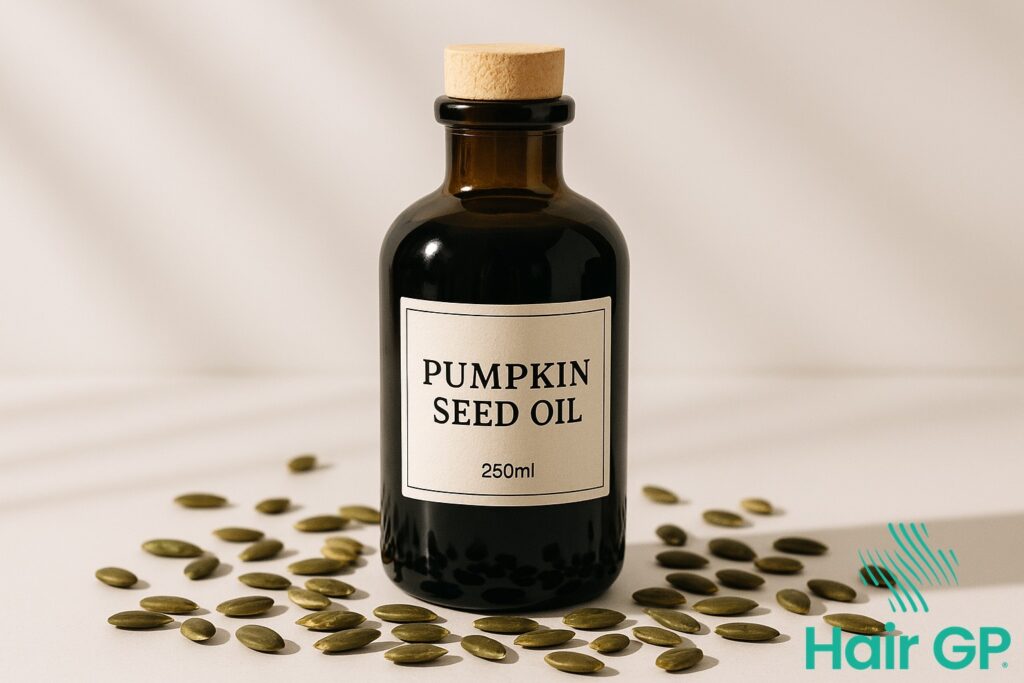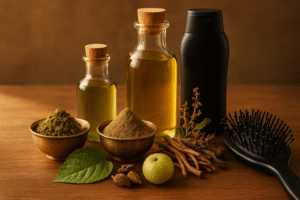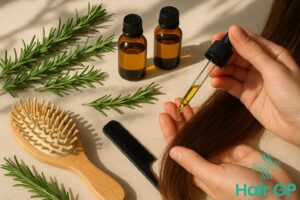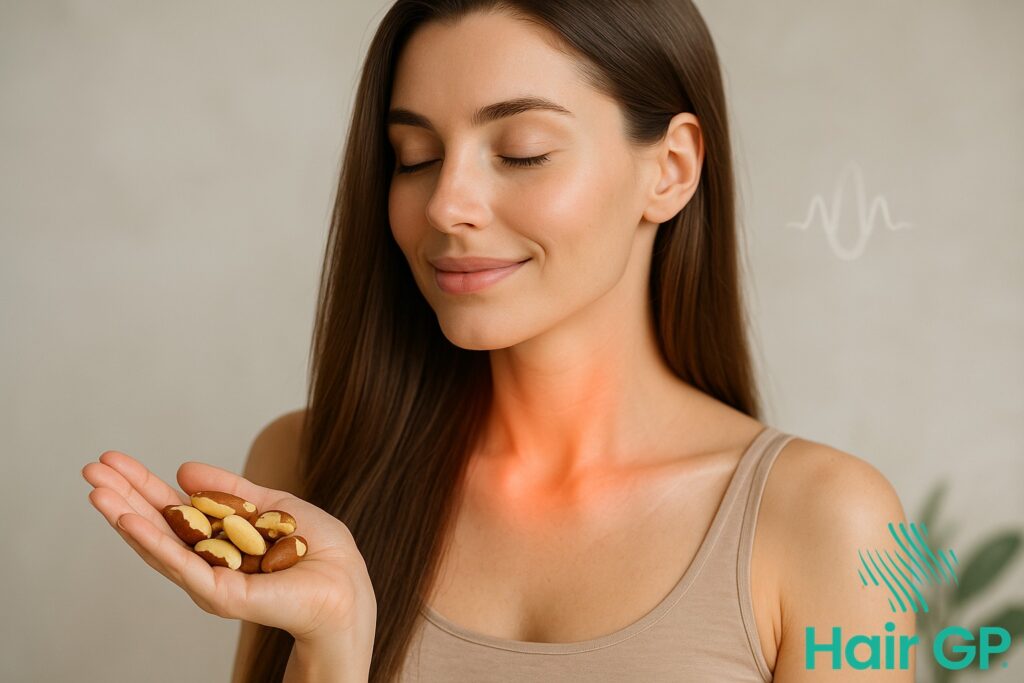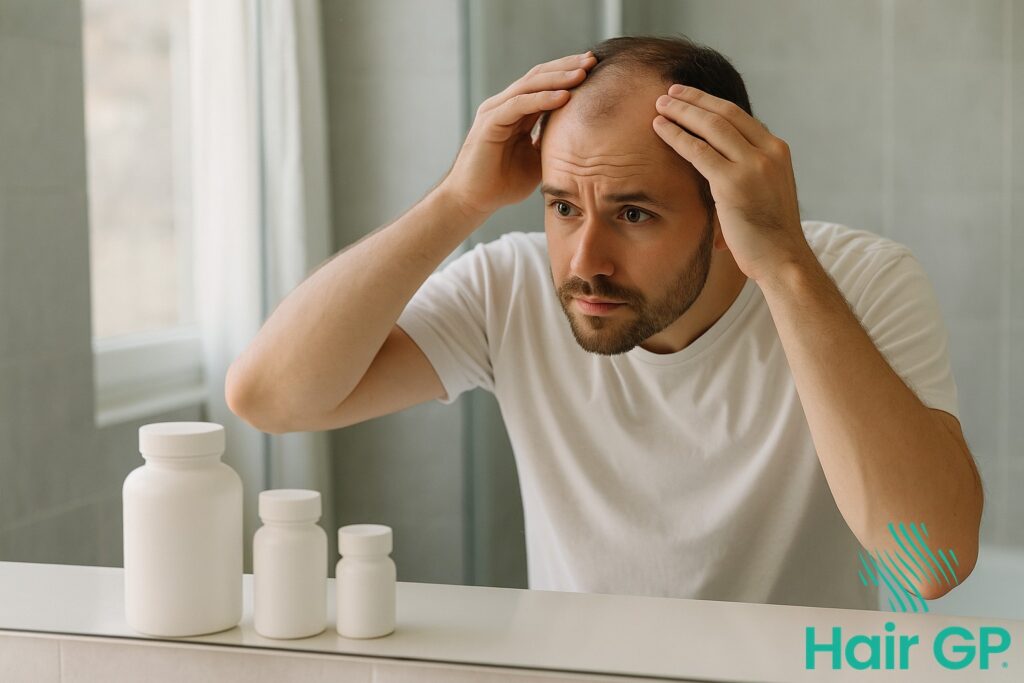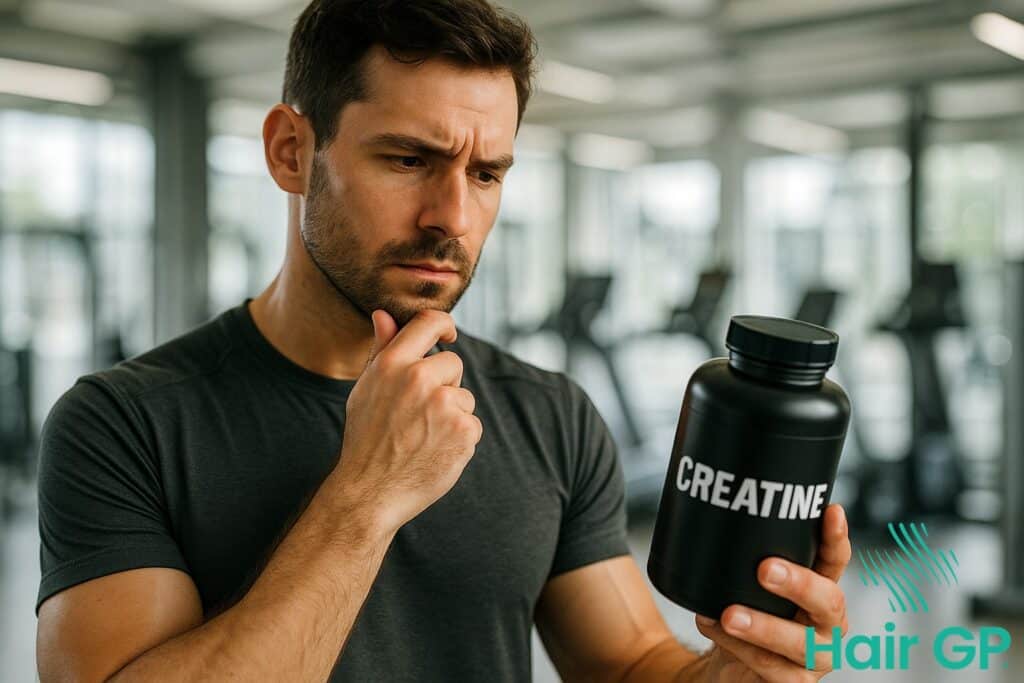Introduction
Hair loss affects millions of people worldwide, with approximately two-thirds of men experiencing noticeable thinning by age 35 and 40% of women facing similar challenges by menopause. As conventional hair loss treatments often come with unwanted side effects or hefty price tags, many are turning to natural alternatives for relief. Among these, pumpkin seed oil has emerged as a popular natural hair supplement, backed by intriguing preliminary research and centuries of traditional use.
However, as with many trending remedies, the marketing surrounding pumpkin seed oil often outpaces the actual scientific evidence. Bold claims about miraculous hair regrowth flood social media and product pages, leaving consumers wondering what’s real and what’s simply clever marketing.
This article cuts through the noise to examine what we truly know about pumpkin seed oil for hair loss. We’ll explore the oil’s nutritional composition and active compounds, understand the biological mechanisms behind hair thinning, and critically evaluate the clinical research. We’ll also compare its effectiveness to established treatments, identify which marketing claims hold water, and provide evidence-based guidance on proper usage. By the end, you’ll have a clear understanding of whether pumpkin seed oil deserves a place in your hair care routine.
Key Takeaways – TL/DR
- One clinical study showed 40% increase in hair count with pumpkin seed oil supplementation over 24 weeks
- Pumpkin seed oil may work as a natural DHT blocker, but evidence is limited compared to proven treatments
- Marketing claims often exaggerate benefits beyond what clinical research supports
- Works best as complementary treatment alongside established hair loss therapies
- Topical application lacks scientific backing; oral supplementation shows more promise
What is Pumpkin Seed Oil?
Pumpkin seed oil is a rich, dark green oil extracted from the seeds of Cucurbita pepo, commonly known as pumpkin. This nutrient-dense oil has gained recognition as one of the most promising natural supplements for hair health, thanks to its unique composition of bioactive compounds. The oil’s distinctive colour comes from its high concentration of carotenoids and chlorophyll, which contribute to its potent antioxidant properties.
The nutritional profile of pumpkin seed oil is particularly impressive, containing high levels of polyunsaturated fatty acids, including linoleic acid (45-60%) and oleic acid (25-35%)[1]. Additionally, it’s an excellent source of vitamin E, specifically gamma-tocopherol, which plays a crucial role in protecting hair follicles from oxidative stress. The oil also contains significant amounts of phytosterols, particularly beta-sitosterol, which has been linked to potential hair growth benefits[2].
Traditionally, pumpkin seed oil has been used in folk medicine across Central Europe for centuries, particularly in Austria where it’s known as “green gold.” Unlike many essential oils, pumpkin seed oil is typically consumed orally as a dietary supplement rather than applied topically, making it a convenient addition to daily wellness routines.
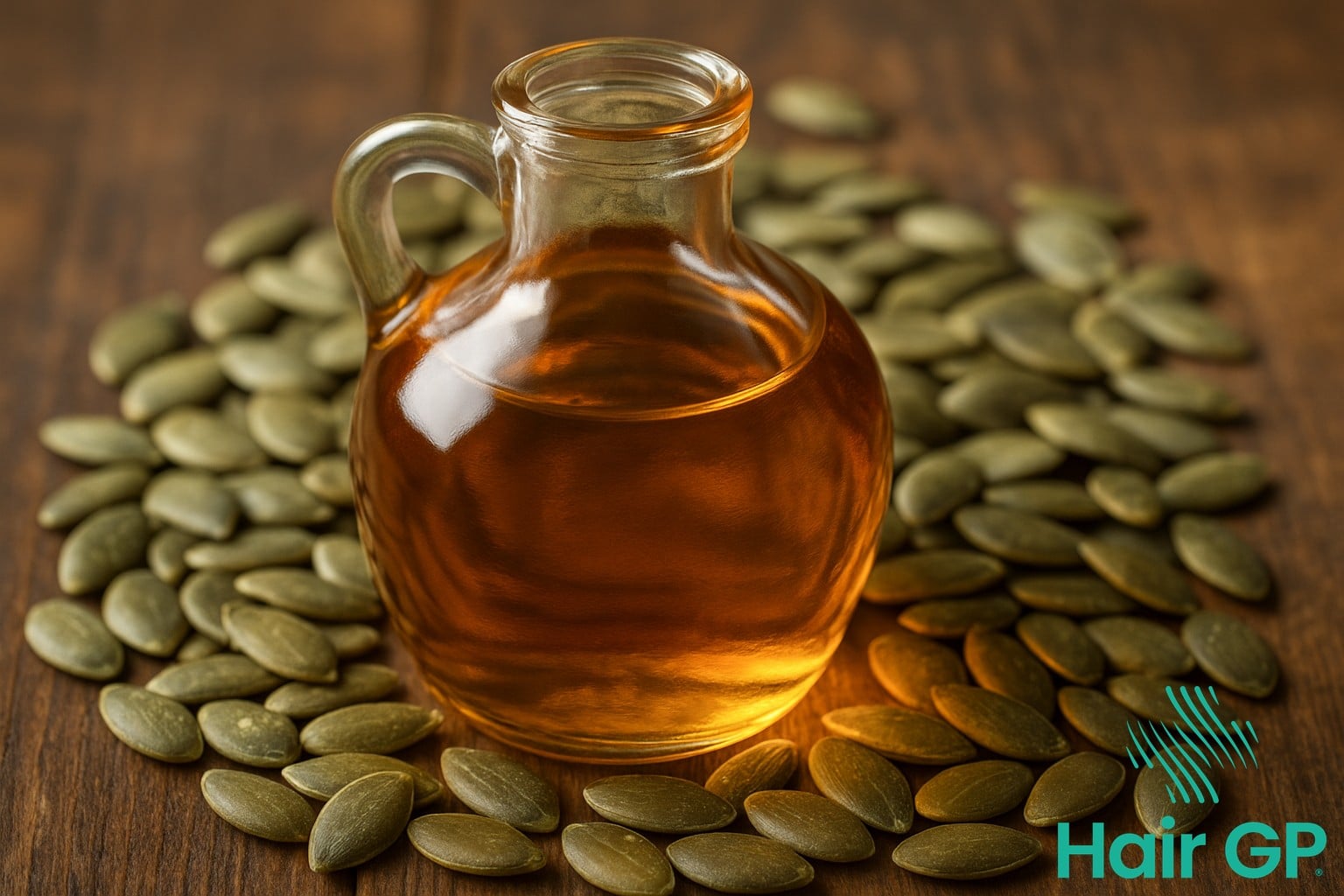
The Science Behind Hair Loss
Understanding the biological mechanisms behind hair loss is crucial for making informed decisions about treatment options. Hair loss isn’t simply a cosmetic issue—it’s a complex biological process involving hormones, genetics, and cellular changes that affect millions of people worldwide.
Understanding Hair Growth Cycles
Hair growth follows a predictable three-phase cycle that determines the health and longevity of each strand. The anagen phase represents active growth, lasting 2-7 years and determining maximum hair length. During this phase, hair follicles are most responsive to nutritional support and treatment interventions. The catagen phase marks a brief 2-3 week transition period where growth slows and the follicle begins to shrink. Finally, the telogen phase involves a 2-3 month resting period before the hair sheds naturally and the cycle begins anew.
In healthy individuals, approximately 85-90% of hair remains in the active growth phase at any given time. However, various factors can disrupt this balance, shortening the anagen phase and extending the telogen phase, resulting in thinner hair coverage and eventual baldness.
Types of Hair Loss
Male pattern baldness, scientifically known as androgenetic alopecia, accounts for over 95% of hair loss in men. This hereditary condition follows predictable patterns, typically beginning with temple recession and crown thinning before progressing to more extensive balding. The process is gradual, often taking decades to reach advanced stages.
Other forms of hair loss include alopecia areata (autoimmune-related patchy hair loss), telogen effluvium (temporary shedding due to stress or illness), and traction alopecia (caused by tight hairstyles or mechanical damage). Each type requires different treatment approaches, making accurate diagnosis essential.
The Role of DHT in Hair Miniaturization
Dihydrotestosterone (DHT) serves as the primary culprit in androgenetic alopecia. This potent hormone, derived from testosterone through the enzyme 5-alpha reductase, binds to receptors in genetically susceptible hair follicles. Over time, DHT exposure causes hair follicles to gradually shrink through a process called miniaturization.
During miniaturization, affected follicles produce progressively shorter, finer hair with each growth cycle. Eventually, these miniaturized follicles become so small they can no longer produce visible hair, creating the appearance of baldness. This process explains why DHT blockers form the foundation of most effective hair loss treatments, as they target the root cause rather than merely addressing symptoms.
Clinical Evidence for Pumpkin Seed Oil
While pumpkin seed oil has gained attention as a natural remedy to combat hair loss, the scientific evidence supporting its use remains limited but intriguing. The most frequently cited research comes from a single randomised controlled trial that showed promising results for promoting hair growth, though experts caution that more comprehensive studies are needed to establish proven efficacy. At Hair GP we would always be cautious around a single study as this is a weak form of evidence.
The 2014 Korean Study
The pivotal research supporting pumpkin seed oil for hair regrowth emerged from a 2014 randomised, double-blind, placebo-controlled trial conducted in South Korea [3]. This study enrolled 76 male participants with mild to moderate androgenetic alopecia, dividing them into treatment and placebo groups. Participants received 400mg of pumpkin seed oil daily in capsule form over a 24-week period.
The results appeared remarkably positive: men taking pumpkin seed oil experienced a 40% increase in hair count compared to just 10% in the placebo group [3]. Additionally, the treatment group showed significant improvements in hair thickness and overall scalp coverage. Researchers attributed these effects to the oil’s ability to inhibit 5-alpha reductase, the enzyme responsible for converting testosterone to DHT, suggesting comparable efficacy to some pharmaceutical interventions whilst avoiding common side effects.
Limitations of Current Research
Despite these encouraging findings, significant gaps remain in the evidence base for pumpkin seed oil as a hair loss treatment. The Korean study’s small sample size of 76 participants limits the generalisability of results, particularly as it excluded women entirely. This absence of female-specific research is particularly problematic given the different hormonal mechanisms underlying hair loss between sexes.
Furthermore, the lack of long-term data raises questions about sustained efficacy and safety. The 24-week study duration provides no insight into whether benefits persist with continued use or if tolerance develops over time. No subsequent large-scale trials have replicated these findings, leaving healthcare providers with insufficient evidence to make confident recommendations. Until more robust research emerges, pumpkin seed oil remains a promising but unproven option for those seeking natural hair loss solutions.

How Pumpkin Seed Oil Works for Hair
Pumpkin seed oil may support hair health through multiple biological mechanisms, primarily by potentially inhibiting the enzyme 5-alpha reductase and providing essential nutrients to hair follicles. Understanding these pathways helps explain why some people experience improvements in hair growth when using this natural supplement.
DHT Blocking Properties
The primary mechanism through which pumpkin seed oil may benefit hair involves its phytosterol content, particularly beta-sitosterol. These plant compounds can potentially inhibit 5-alpha reductase, the enzyme responsible for converting testosterone to dihydrotestosterone (DHT) [4]. When DHT binds to receptors in hair follicles, it can lead to shrinking hair follicles and eventual hair loss. By potentially reducing DHT levels, pumpkin seed oil may function similarly to other dht blockers, though with milder effects. The oil contains approximately 265 mg of phytosterols per 100g, with beta-sitosterol comprising the largest portion [2].
Nutritional Support for Hair Follicles
Beyond its potential to block dht, pumpkin seed oil provides nutritional support crucial for hair health. The oil is rich in omega-3 and omega-6 fatty acids, which help maintain healthy cell membranes in hair follicles. Its zinc content (approximately 7.5 mg per 100g) plays a vital role in protein synthesis and cell division necessary for hair growth. Additionally, pumpkin seed oil contains antioxidants including vitamin E and carotenoids, which protect hair follicles from oxidative stress that can impair growth and contribute to premature hair loss.
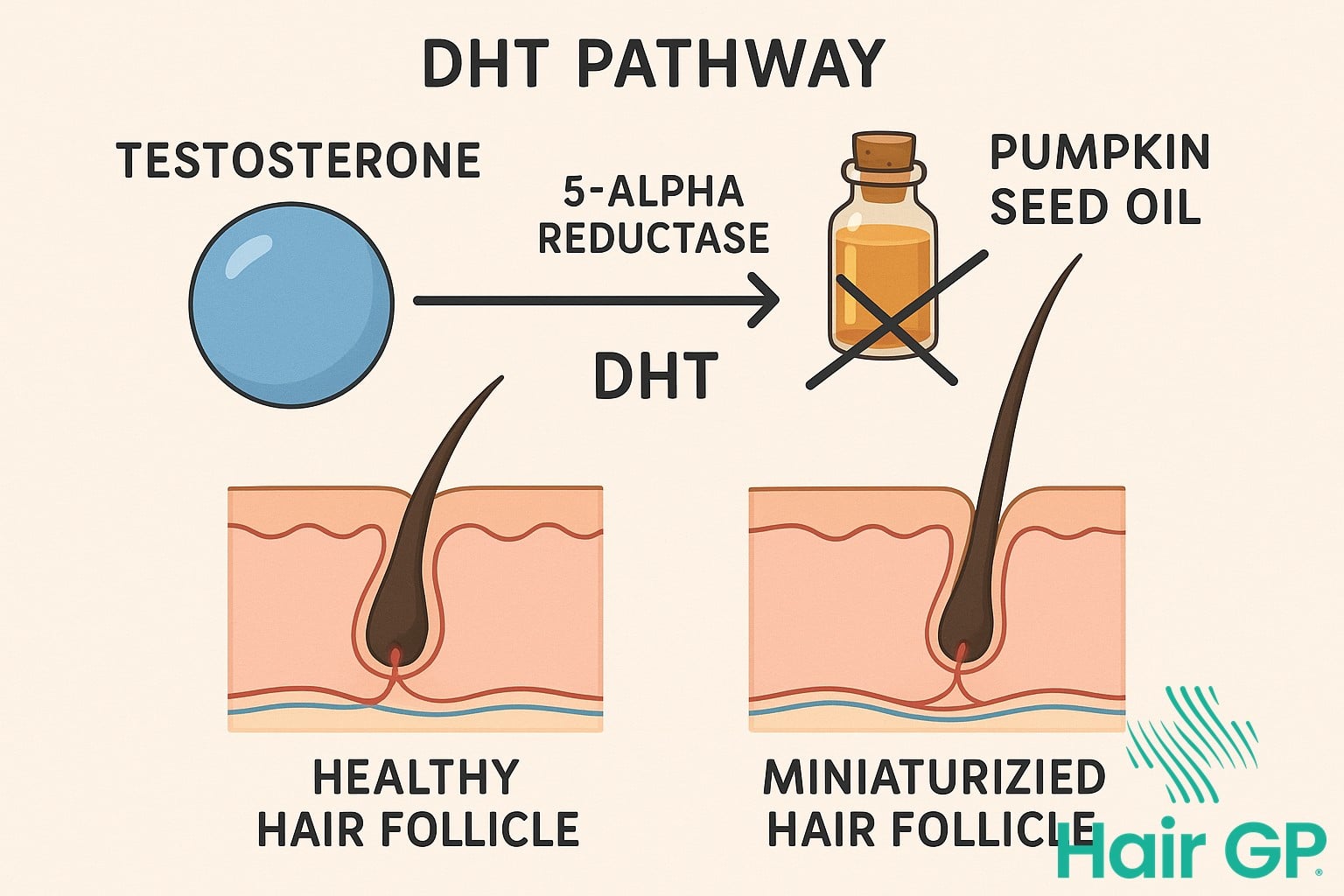
Comparison with Other Hair Loss Treatments
Understanding how pumpkin seed oil stacks up against other hair loss treatments helps provide realistic expectations and informs treatment decisions. While pumpkin seed oil shows promise, established treatments offer more robust clinical evidence and higher success rates.
FDA-Approved Treatments
Finasteride demonstrates clinical effectiveness in 90% of men with male pattern baldness, with approximately two-thirds experiencing regrowth. This oral medication targets DHT production directly and represents the gold standard for hair loss treatment. Combined oral minoxidil-finasteride regimens show particularly impressive results, with 92.4% of patients seeing their hair loss halted or improved over 12 months.
Minoxidil, available in 2% and 5% topical formulations, works by improving blood flow to hair follicles and extending the growth phase. While individual response rates vary, clinical studies consistently demonstrate its effectiveness in slowing hair loss and promoting regrowth. The combination of minoxidil and finasteride often produces superior results compared to either treatment alone.
Both FDA-approved treatments have well-documented side effect profiles. Finasteride may cause sexual side effects in a small percentage of users, while minoxidil can cause scalp irritation and unwanted facial hair growth in some individuals.
Natural Alternatives
Among natural options, saw palmetto can improve total hair count by 27% and hair density in 83% of men and women with pattern hair loss when taken orally or applied topically. However, studies reveal only weak DHT blocking effects, significantly lower than finasteride results.
Rosemary oil has proven effective in treating androgenetic alopecia when compared to baseline or established medications like minoxidil, presenting minimal side effects. Some studies suggest rosemary oil performs comparably to 2% minoxidil in promoting hair growth.
Pumpkin seed oil fits within this natural treatment category, offering similar modest benefits with minimal adverse effects. Natural agents like pumpkin seed oil, saw palmetto, and rosemary oil present minimal side effects compared to pharmaceutical options, making them attractive for individuals seeking gentler approaches to hair loss management.
Marketing Claims vs Reality
The supplement industry frequently makes bold promises about pumpkin seed oil’s ability to restore hair, but understanding the difference between marketing hype and scientific reality is crucial for setting appropriate expectations.
Common marketing claims suggest dramatic hair regrowth within weeks or months, often accompanied by before-and-after photos showing remarkable transformations. However, the single clinical study on pumpkin seed oil showed modest improvements—a 40% increase in hair count over 24 weeks, which translates to gradual changes rather than dramatic overnight results.
Many advertisements promise to restore “thick, healthy hair” or guarantee “more hair” without mentioning that individual results vary significantly. The reality is that pumpkin seed oil may help slow hair loss and provide subtle improvements in hair density for some people, particularly those in early stages of thinning hair. Complete restoration of severely balding areas remains unlikely based on current evidence.
Marketing materials often use phrases like “clinically proven” while referencing limited preliminary research. While studies do exist, the evidence base remains narrow compared to established treatments. Some products combine pumpkin seed oil with multiple other ingredients, making it impossible to determine which components contribute to any observed benefits.
Be wary of testimonials featuring dramatic transformations or claims of “guaranteed results.” Legitimate hair loss treatments require patience, consistency, and realistic expectations. The most honest assessment suggests pumpkin seed oil may offer modest support for maintaining existing hair rather than dramatic regrowth, especially when used as part of a comprehensive approach to hair health.
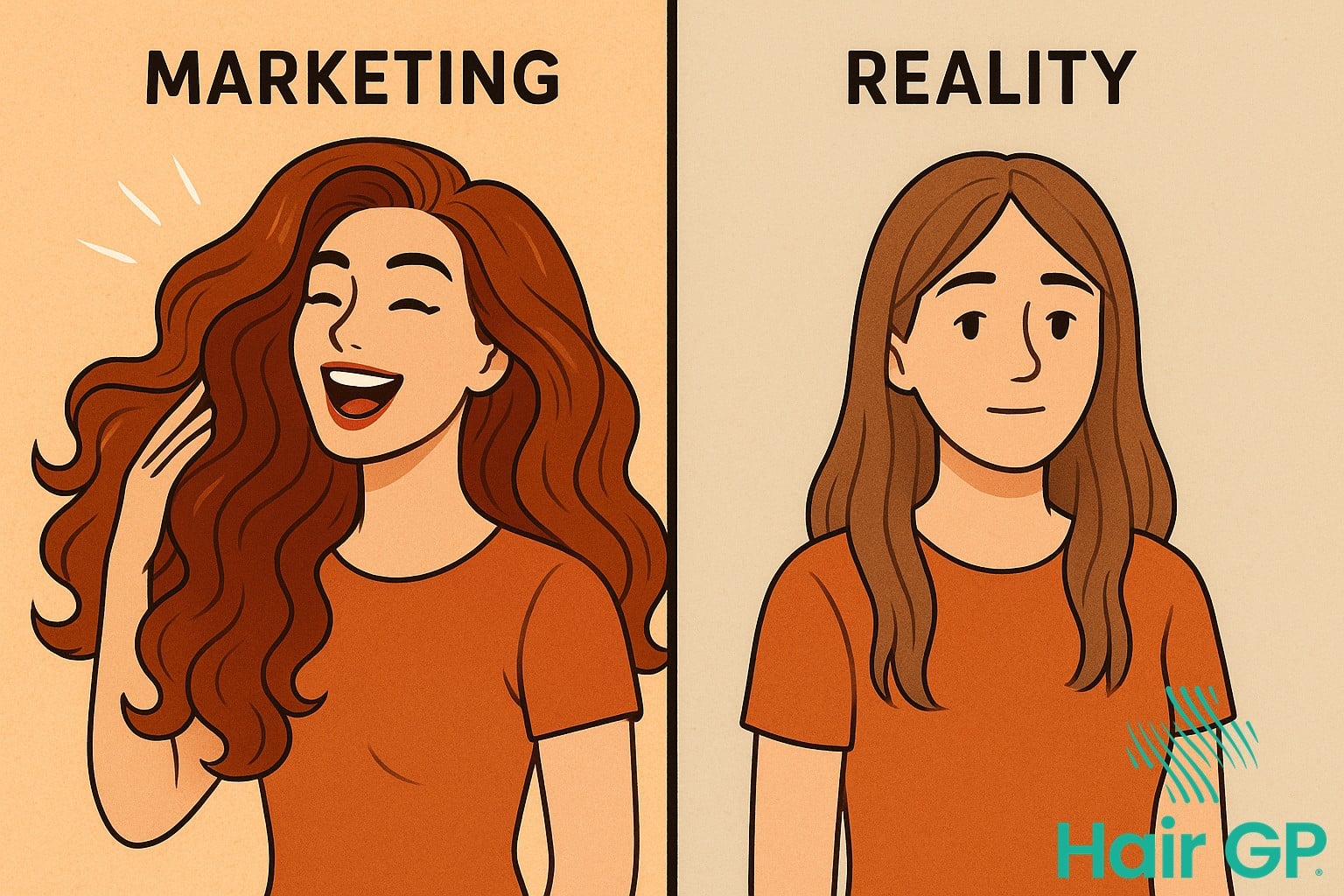
How to Use Pumpkin Seed Oil for Hair Loss
For those interested in trying pumpkin seed oil to treat hair loss, several application methods show potential based on available research. The most studied approach involves taking 400mg of pumpkin seed oil in capsule form daily, preferably with meals to improve absorption and reduce potential stomach irritation.
Topical application offers another option, though less research supports this method. Mix a few drops of pure pumpkin seed oil with a carrier oil like jojoba or coconut oil before applying to the scalp. Gentle scalp massage during application may improve circulation and help the oil penetrate more effectively. Leave the mixture on for 30 minutes to several hours before washing with mild shampoos.
Some manufacturers now include pumpkin seed oil in specialized hair care shampoos and conditioners, though the concentration and effectiveness of these products vary significantly. While convenient, these formulations typically contain lower concentrations than supplements or pure oil applications.
Consider combining pumpkin seed oil with other supplements known to support hair health, such as iron, or vitamin D, after consulting with a healthcare provider about appropriate combinations for your situation. Remember that consistency is key—any potential benefits typically require several months of regular use to become noticeable.
Start with lower doses or concentrations to assess your individual tolerance before increasing usage.
Conclusion
Pumpkin seed oil represents an intriguing natural option for those experiencing hair loss, but it’s essential to maintain realistic expectations about its effectiveness. While preliminary research suggests potential benefits through DHT inhibition and anti-inflammatory properties, the evidence remains limited compared to clinically proven treatments like finasteride and minoxidil.
The most compelling study showed a 40% increase in hair count among participants using pumpkin seed oil supplements over 24 weeks. However, this single trial involved only 76 men, and the results haven’t been replicated in larger, independent studies. For individuals in early stages of hair loss or those seeking natural alternatives, pumpkin seed oil may offer modest benefits with minimal side effects.
Rather than viewing pumpkin seed oil as a standalone solution, consider it as one component of a comprehensive hair loss strategy. Combining it with proven treatments, proper nutrition, stress management, and appropriate hair care practices may yield better results than relying on any single intervention.
For those experiencing significant hair loss, consulting with a dermatologist or hair loss specialist remains crucial. They can provide personalized treatment plans based on your specific condition, medical history, and goals. While pumpkin seed oil shows promise, established treatments offer more predictable outcomes for serious hair growth concerns.
Ultimately, managing hair loss effectively often requires patience, consistency, and realistic expectations regardless of the chosen approach.
Frequently Asked Questions
Limited clinical evidence suggests pumpkin seed oil may help with hair loss. One study showed a 40% increase in hair count over 24 weeks, but more research is needed to confirm effectiveness across different populations.
Based on clinical studies, visible improvements may take 3-6 months of consistent use. The 2014 study showed significant results after 24 weeks of daily supplementation.
No current evidence suggests pumpkin seed oil is more effective than minoxidil. Minoxidil has decades of research and FDA approval, while pumpkin seed oil has limited studies. They may work through different mechanisms and could potentially be used together.
While pumpkin seed oil is generally safe for women, most hair loss studies have focused on men. Women experiencing hair loss should consult healthcare providers, as female pattern hair loss often has different causes requiring specific treatments.
Pumpkin seed oil is generally well-tolerated with minimal side effects. Some people may experience mild digestive upset when taken orally. Unlike finasteride, it doesn’t appear to cause sexual side effects, though long-term safety data is limited.
References
- Fruhwirth GO, Hermetter A. Seeds and oil of the Styrian oil pumpkin: Components and biological activities. Eur J Lipid Sci Technol. 2007;109(11):1128-1140.
- Cho YH, Lee SY, Jeong DW, et al. Effect of pumpkin seed oil on hair growth in men with androgenetic alopecia: a randomized, double-blind, placebo-controlled trial. Evid Based Complement Alternat Med. 2014;2014:549721.
- Cho YH, Lee SY, Jeong DW, et al. Effect of pumpkin seed oil on hair growth in men with androgenetic alopecia: a randomized, double-blind, placebo-controlled trial. Evid Based Complement Alternat Med. 2014;2014:549721.
- Prager N, Bickett K, French N, Marcovici G. A randomized, double-blind, placebo-controlled trial to determine the effectiveness of botanically derived inhibitors of 5-alpha-reductase in the treatment of androgenetic alopecia. J Altern Complement Med. 2002;8(2):143-152.

